
Concept explainers
(a)
Interpretation:
The amine needs to be labeled as 10, 20 or 30.
Concept introduction:
Answer to Problem 73P
A tertiary (3o) amine.
Explanation of Solution
Amines are derivatives which are derived from ammonia, wherein one or more hydrogen atoms have been replaced by a substituent such as an alkyl or aryl group. They can be called as alkylamines and arylamines.
Whether an amine is primary (1o), secondary (2o) or tertiary (3o) depends on the number of hydrogen atoms replaced by an alkyl or aryl group in ammonia. The amine is a primary amine if one hydrogen atom is replaced, it is a secondary amine if 2 hydrogen atoms are replaced and if three hydrogen atoms are replaced, it is known as a tertiary amine.
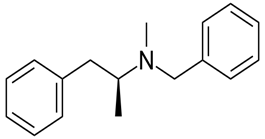
Here, all three hydrogen atoms are replaced and therefore this amine called a tertiary (3o) amine.
(b)
Interpretation:
The chiral center of the benzphetamine molecule needs to be labeled.
Concept Introduction:
The molecules with a chiral center can form a superimposable mirror image and is known as enantiomers. There should not be any plane of symmetry in a molecule to be chiral. A plane that bisects a molecule into two equal halves is known as a plane of symmetry. If there is a plane of symmetry in a molecule and it is identical to any of its mirror image, it is considered as achiral. The chiral center is carbon attached to 4 different groups attached to it.
Answer to Problem 73P
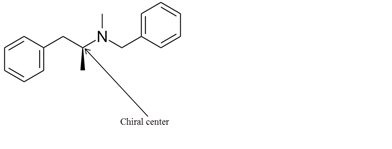
Explanation of Solution
The chiral center in the given molecule is shown as follows:
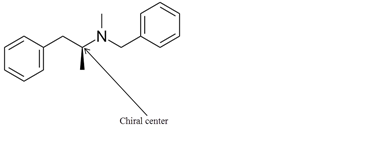
The labeled carbon atom is attached to 4 different groups.
The chiral center has four different groups attached to carbon and no plane of symmetry. The molecule with a chiral center shows optical isomerism. The chiral center is a stereocenter holding the atoms in space, the mirror image so formed are not superimposable.
(c)
Interpretation:
The enantiomers of benzphetamine molecule needs to be determined.
Concept introduction:
The chiral molecules which are mirror images of each other are known as enantiomers. They are non-superimposable mirror images, or they cannot be placed on top of each other.
Answer to Problem 73P

Explanation of Solution
Benzphetamine has two enantiomers due to its one chiral center. It rotates the plane-polarized light. Here, S-benzphetamine rotates the light anticlockwise and R- benzphetamine rotates it clockwise.

Benzphetaminecan can be called as a racemic mixture of two enantiomers, which are R(+) and S(-).
(d)
Interpretation:
The constitutional isomer that contains a primary amine needs to be drawn.
Concept introduction:
Constitutional isomers have the same molecular formula but different structural connectivity. The number of each atom in both the molecules needs to be counted and the arrangement is observed to check whether two molecules are a constitutional isomer of each other or not.
Answer to Problem 73P
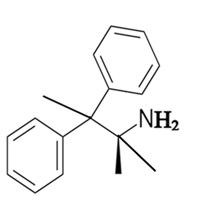
Explanation of Solution
Whether an amine is primary (1o), secondary (2o) or tertiary (3o) depends on the number of hydrogen atoms replaced by an alkyl or aryl group in ammonia. The amine is a primary amine if one hydrogen atom is replaced, it is a secondary amine if 2 hydrogen atoms are replaced and if three hydrogen atoms are replaced it is known as a tertiary amine.
The given compound is as follows:

The constitutional isomer with a primary amine is as follows:
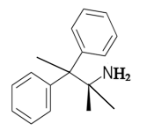
Here, only one hydrogen atom is replaced therefore this amine called a primary amine (1o).
(e)
Interpretation:
The constitutional isomer that contains a tertiary amine needs to be determined.
Concept introduction:
Constitutional isomers have the same molecular formula but different structural connectivity. The number of each atom in both the molecules needs to be counted and the arrangement is observed to check whether two molecules are a constitutional isomer of each other or not.
Answer to Problem 73P
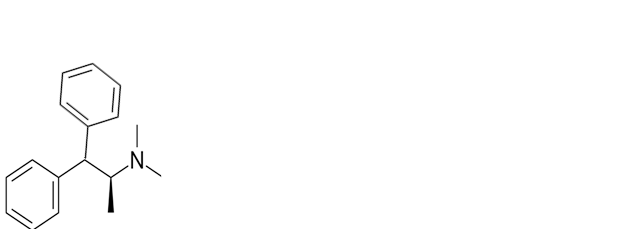
Explanation of Solution
Whether an amine is primary (1o), secondary (2o) or tertiary (3o) depends on the number of hydrogen atoms replaced by an alkyl or aryl group in ammonia. The amine is a primary amine if one hydrogen atom is replaced, it is a secondary amine if 2 hydrogen atoms are replaced and if three hydrogen atoms are replaced it is known as a tertiary amine.
The given compound is as follows:
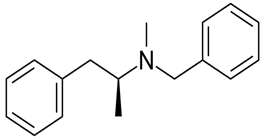
The constitutional isomer with a tertiary amine is represented as follows:
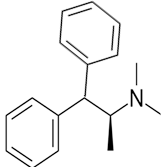
Here all 3 hydrogen atomsare replaced and therefore this amine called as a tertiary amine (3o).
(f)
Interpretation:
The structure of benzphetaminehychloride molecule needs to be drawn.
Concept introduction:
Benzphetamine hydrochloride can be defined as the hydrochloride salt version of benzphetamine.
Answer to Problem 73P
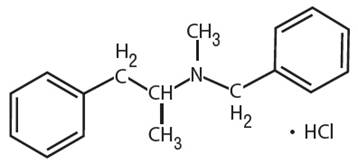
Explanation of Solution
Benzphetamine hydrochloride can be defined as the hydrochloride salt version of benzphetamine. Its molecular formula is C17H22ClN. It has the following structure.

(g)
Interpretation:
The products formed if benzphetamine is treated with acetic acid needs to be determined.
Concept introduction:
Amines are derived from ammonia and formed by replacement of one or more hydrogen atoms by alkyl or aryl groups. They can be called as alkylamines and arylamines. Benzphetamine is a tertiary amine.
Answer to Problem 73P
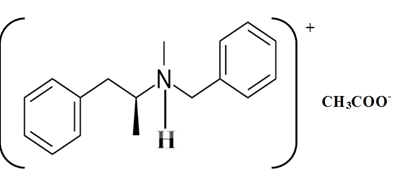
Explanation of Solution
Whether an amine is primary (1o), secondary (2o) or tertiary (3o) depends on the number of hydrogen atoms replaced by an alkyl or aryl group in ammonia. The amine is a primary amine if one hydrogen atom is replaced, it is a secondary amine if 2 hydrogen atoms are replaced and if three hydrogen atoms are replaced it is known as a tertiary amine.
Benzphetamine is a tertiary ammine. It has basic properties and it accepts protons from acids. Acetic acid donates a proton to this amine and formed below the salt.
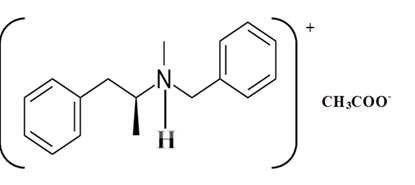
Want to see more full solutions like this?
Chapter 18 Solutions
CONNECT IA GENERAL ORGANIC&BIO CHEMISTRY
- Identify and provide a concise explanation of the concept of signal-to-noise ratio (SNR) in the context of chemical analysis. Provide specific examples.arrow_forwardIdentify and provide a concise explanation of a specific analytical instrument capable of detecting and quantifying trace compounds in food samples. Emphasise the instrumental capabilities relevant to trace compound analysis in the nominated food. Include the specific application name (eg: identification and quantification of mercury in salmon), outline a brief description of sample preparation procedures, and provide a summary of the obtained results from the analytical process.arrow_forwardIdentify and provide an explanation of what 'Seperation Science' is. Also describe its importance with the respect to the chemical analysis of food. Provide specific examples.arrow_forward
- 5. Propose a Synthesis for the molecule below. You may use any starting materials containing 6 carbons or less (reagents that aren't incorporated into the final molecule such as PhзP do not count towards this total, and the starting material can have whatever non-carbon functional groups you want), and any of the reactions you have learned so far in organic chemistry I, II, and III. Your final answer should show each step separately, with intermediates and conditions clearly drawn. H3C CH3arrow_forwardState the name and condensed formula of isooxazole obtained by reacting acetylacetone and hydroxylamine.arrow_forwardState the name and condensed formula of the isothiazole obtained by reacting acetylacetone and thiosemicarbazide.arrow_forward
- Provide the semi-developed formula of isooxazole obtained by reacting acetylacetone and hydroxylamine.arrow_forwardGiven a 1,3-dicarbonyl compound (R1-CO-CH2-CO-R2), indicate the formula of the compound obtaineda) if I add hydroxylamine (NH2OH) to give an isooxazole.b) if I add thiosemicarbazide (NH2-CO-NH-NH2) to give an isothiazole.arrow_forwardAn orange laser has a wavelength of 610 nm. What is the energy of this light?arrow_forward
- The molar absorptivity of a protein in water at 280 nm can be estimated within ~5-10% from its content of the amino acids tyrosine and tryptophan and from the number of disulfide linkages (R-S-S-R) between cysteine residues: Ε280 nm (M-1 cm-1) ≈ 5500 nTrp + 1490 nTyr + 125 nS-S where nTrp is the number of tryptophans, nTyr is the number of tyrosines, and nS-S is the number of disulfide linkages. The protein human serum transferrin has 678 amino acids including 8 tryptophans, 26 tyrosines, and 19 disulfide linkages. The molecular mass of the most dominant for is 79550. Predict the molar absorptivity of transferrin. Predict the absorbance of a solution that’s 1.000 g/L transferrin in a 1.000-cm-pathlength cuvet. Estimate the g/L of a transferrin solution with an absorbance of 1.50 at 280 nm.arrow_forwardIn GC, what order will the following molecules elute from the column? CH3OCH3, CH3CH2OH, C3H8, C4H10arrow_forwardBeer’s Law is A = εbc, where A is absorbance, ε is the molar absorptivity (which is specific to the compound and wavelength in the measurement), and c is concentration. The absorbance of a 2.31 × 10-5 M solution of a compound is 0.822 at a wavelength of 266 nm in a 1.00-cm cell. Calculate the molar absorptivity at 266 nm.arrow_forward
 Chemistry for Today: General, Organic, and Bioche...ChemistryISBN:9781305960060Author:Spencer L. Seager, Michael R. Slabaugh, Maren S. HansenPublisher:Cengage Learning
Chemistry for Today: General, Organic, and Bioche...ChemistryISBN:9781305960060Author:Spencer L. Seager, Michael R. Slabaugh, Maren S. HansenPublisher:Cengage Learning Organic ChemistryChemistryISBN:9781305580350Author:William H. Brown, Brent L. Iverson, Eric Anslyn, Christopher S. FootePublisher:Cengage Learning
Organic ChemistryChemistryISBN:9781305580350Author:William H. Brown, Brent L. Iverson, Eric Anslyn, Christopher S. FootePublisher:Cengage Learning Organic Chemistry: A Guided InquiryChemistryISBN:9780618974122Author:Andrei StraumanisPublisher:Cengage Learning
Organic Chemistry: A Guided InquiryChemistryISBN:9780618974122Author:Andrei StraumanisPublisher:Cengage Learning


